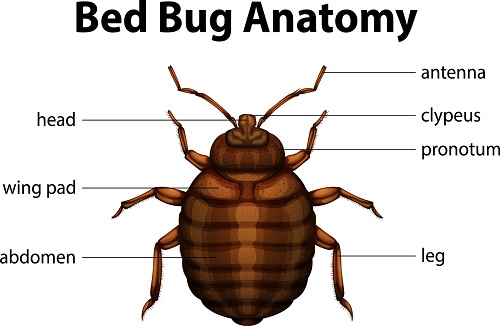Serving Washington DC, Maryland, Virginia & Georgia

Bed Bugs
Bed Bugs are members of the insect Family Cimicidae, in the Order Hemiptera and in the Suborder Heteroptera, also known as true bugs. There are 3 species of bed bugs that can infest your home in the United States, especially in states like Pennsylvania, Maryland, Virginia, West Virginia, North Carolina, South Carolina, Georgia, Louisiana, Florida, and more.
These parasitic insects are reddish brown, flat, oval with no hind wings. Thier flattened anatomy allows them to easily hide in cracks and crevices. Their abdomens are segmented with microscopic hairs. These segments are what gives them a banded appearance. Adult Bed Bugs can grow up to 5mm in length and 3mm wide.
The Common Bed Bug
Cimex lectularius Linnaeus "The Common Bed Bug" are the most common species of bed bug infestions.
Adults are 1/5-1/4-inch long and are typically reddish brown to mahogany brown in color. Their bodies are covered in tiny golden hairs that are nearly invisible to the naked eye. Bed bugs have an incomplete life cycle going through 5 nymphal stages. To develop from one stage to each successive stage, the bed bug requires a blood meal. Bed bug stretch in size about 130% to 200% after fully engorging on a blood meal. Bed bugs mature from egg-to-egg in approximately 45-60 days. Adult females generally live 6-12 months and produce 200-500 eggs in their lifetime.
The Bat Bug
Cimex pilosellus Horvath "The Bat Bug" commonly infest bat populations.
The bat bug most commonly infests bat populations but can also infest homes and be a parasite to human hosts when bats occupy homes and attics. If bat bugs are found in or around your home, you may need to contact a specialized wildlife removal expert to remove and exclude bats prior to addressing a bat bug infestation. Bat bug infestations can then be treated by pest control expert trained in handling such infestations.
Bed Bug Life Cycle

Tropical Bed Bug
Well established in Florida and quickly spreading throughout the southeast. In some infestations, both the tropical bed bug and the common bed bug species may be present.
References
**Bennett, Garry, Owens, Corrigan. Truman’s Scientific Guide to Pest Management Operations 7th edition. A Purdue University North Coast Media LLC Project
***Gangloff-Kaufman. J. et al. 2006 “Bed Bugs in America: A Pest Management Industry Survey.” American Entomology Vol. 52
